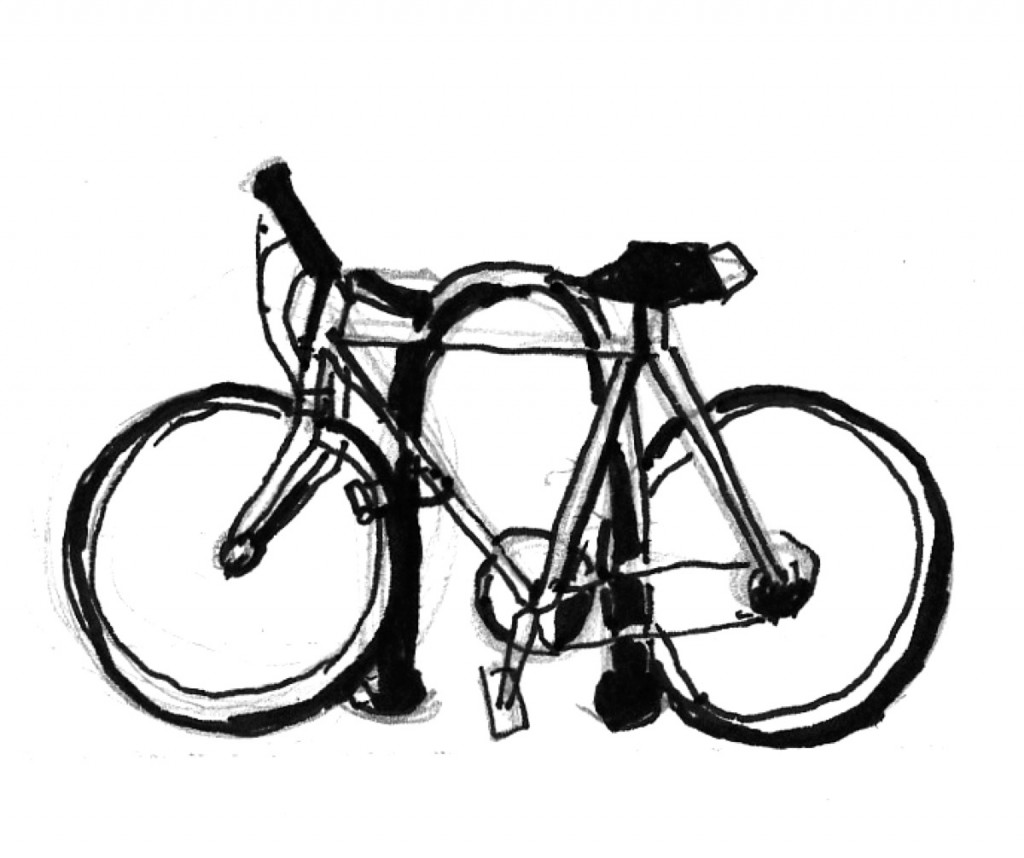
Whether you come to belong to a place depends on how you get there. Sometimes you’re greeted with open arms, and other times—with a bar to the chest. That’s how, until recently, Bass Library greeted bicyclists.
“It’s absurd,” she said. “Almost in your face.” The silver-haired woman stared at a bar four inches in diameter and 42 inches from the ground. She had dismounted her bee-yellow Motobecane and, unwilling to lift the bike above her waist, now leaned it against the pink stone of the tomb entrance to Bass Library. The bar held a tangle of other bikes in the air, front tires suspended over the top and wrenched at tortuous angles. “I guess racks aren’t designed by people who use them. But that’s true of so many things.”
Yale College dates from 1701, and the geared bicycle from 1885. Among the Gothic- and Georgian-revival architecture, whether and where bikes belong has not always been clear. In early photographs, bikes spread across campus , untethered to racks, and not likely to be rustled. But New Haven’s mid-20th century urban blight brought new threats. Theft rose, and so did the need for Yale students to secure their bikes. Yale at last installed bike racks in the 1960s—more than a decade after the “trick knee” of Whitey Heist ’53 popped out of joint and kept him from finishing the famed 1952 “Beers and Bikes From Yale to Vassar,” and more than seventy years after F.A. Clark, class of 1891, won the two-mile bicycle race for Yale over Harvard. These primitive racks were metal bars hung between heavy wooden posts.
The domestication of bicycles to the Yale aesthetic became more deliberate in the 1990s, when Yale charged landscape architect Channing Harris with designing new racks. Harris, who believes a successful feature should only be noticeable once removed, answered the challenge with a columns and cross-bar design. In the Georgian-revival residential colleges, he selected rough-cut granite for the columns, and in the neo-Gothic colleges, concrete posts that taper upwards to become spires. His favorite “ornament” is in Berkeley College. A repeating pattern of bike racks fences in the courtyard grass. The racks welcome bicyclists without alerting others to anything amiss.
But even as the racks became less visible, the bikes became more so. The design put style above substance, and at times seemed to achieve neither. Without vertical pieces to prop them up, bikes could fall on each other. And clumped on the crossbars, or left locked to trees or posts (as may be more convenient), they continued to resist the order that elsewhere defines Yale’s tradition.
The most delightfully improbable attempt to blend the bike rack into Old Gothic Yale was the pipe at Bass Library. No one who might have designed the rack for the library’s 2007 remodel claimed it when contacted: the contractor insisted that either the architects or the landscape architects specified its design, while they energetically denied having done so (the landscape architects on this project did not include Harris). Until this semester, the metal rack continued to be cause for curiosity and discomfort.
“If you can ride a bicycle, you can lift a bicycle over this bar,” said Steven Garza ’12, which he demonstrated with confidence. But for Elizabeth Walker—“not Rider,” she clarified—this did not seem true. The 63-year-old woman left her yellow bike hobbled against the wall, a U-lock binding the front tire to the frame. While she descended into the library to use the internet, Yifan Chen ’12 climbed up the stairs to unlock his bike. His only complaint about bike racks at Yale was how tall this one was. But then, before complaining further, he reconsidered, and tried to impute an intention to the design.“I don’t know, maybe because there are so many bikes this is how they can best be organized,” he said. He looked over as another rider arrived and began awkwardly turning the heads of several bicycles to create room, struggling simultaneously to lift his bike over the bar with his other hand. “I’m not sure about the mechanics of it,” Chen said, “but I’m sure there is a reason.” (The steel bar, which seemed to have such forbidding permanence, has just this semester met its Maker.)
Other racks at Yale worked better for bikers, but lacked Oxford charm. Like ladders set on their sides, aluminum racks once held bikes outside Harkness Hall. Harris, the landscape architect, guessed that the maintenance staff had installed those racks without consulting campus planners. The incongruity of the choice felt oddly comforting; it felt human, and not institutional.
The dysfunction and disunity of bike racks on campus has once again prompted Yale to redesign them. This past year, Alice Raucher, facilities planner for Yale, worked with Kimo Griggs, a former professor of ornamental architecture at Yale, to make a rack that could embrace bikes where they have struggled to belong. President Levin endorsed their solution as the new standard. The rack has less feudal rusticity, and more corporate polish. No longer a hitching rail, it’s an embellished U turned upside down.
The new racks are elegant and functional, but the old ones will be missed. There was something grand about building a bike rack fit for a horse. “I like that you had to lift up the front tire,” said Garza, “like the bike had to be very well fixed to keep it from pulling itself away.”

